
|
|
Abstract: Personal stories about addiction, alcoholism, and spiritual growth through a then-new group called "Bahá'ís in Recovery." Includes letter from Dann Irish introducing the Bahá'ís in Recovery Program. Notes: See also list of dialogue articles or image scans. |
Three Bahá'í Voices
by Esther Bradley-DeTally
published in dialogue, 2:2-3, pages 12-19Los Angeles: 1988
The second voice—velvet, deep, with a touch of a drawl—describes life as a child of a matinee idol in Beverly Hills, California, where a bridle path ran down the middle of Sunset Boulevard. He speaks of childhood beginnings in a thirty-four room house with a six-car garage and servants. A home where military men, movie stars, directors, and producers gathered in a drinking fellowship. He would become what he calls “a Bahá'í wino,” bottomed-out, living in the alleyways, near wet-brain death, twenty-seven years an alcoholic. His name is Bob.
The third voice is snappy, matter-of-fact: “Before I was a Bahá'í, I was practically everything: a fifth of Bourbon a night for twelve years; six packs of cigarettes a day; uppers; sex with two to three dozen people a night.” His name is Ken.
Sam, Bob, and Ken are part of a growing fellowship: Bahá'ís in Recovery. They reveal their stories not to horrify, titillate, or evoke pity. They have forgiven those who have abuse them. When possible, they have made amends to those they have hurt. “Clearing away the wreckage of their past, and living in the solution,” they call it.
Bob, Sam, and Ken hope their addictions and their experience of recovery on a daily basis will reach others who still suffer active addiction.
SAM’S STORY
Sam was born in England just before World War II, the daughter of vaudeville acrobats. Her mother left home when Sam was two years old. Her father remarried another acrobat soon after. Sam was in the way. At age three, she became the youngest of three hundred girls in an austere English boarding school. Until she was nine years old, she would only see her parents twice a year: in summer and at Christmas. When the school was closed down for holidays, one teacher would have to stay with Sam.
At age nine, the adoption of a brother called for Sam’s services at home. Her family travelled to a new town each week to perform. Sam’s job was to scout out the dairy, the butcher, and the baker. Basics aside, she would then present herself to the headmistress of her new school each Monday morning. She was small for her nine years, quiet and withdrawn. The teacher would place her in the back of the classroom. For three years Sam learned nothing. Her stepmother decided Sam was deplorably ignorant and sent away for correspondence courses like those used in the Australian bush. She would be Sam’s teacher. Physical and mental abuse were her teaching tools. Frightened, Sam learned, “You’re no good, you don’t deserve any more education, you must quit school.”
At age fourteen, untrained, she found a job as a file clerk in a law office and a place to live with an older couple near her work. The couple loved her and were kind to Sam. Her stepmother grew jealous. She wanted the room and board money Sam could give her. Sam was pressured to return home.
She found another job. She also found the bars along the docks. Sam discovered alcohol stopped pain. She recalls, “This magic drug called alcohol said, ‘Drink me, I will release you from this dark pit,’ so I drank. I went into unreality. I didn’t have to think of the pain. I didn’t have to think of the torment that went on on a daily basis. I didn’t have to think of anything. That’s how I got started. I drank like an alcoholic right from the beginning; had blackouts right from the beginning. I did very bizarre things right from the beginning.”
At seventeen, with a borrowed suitcase and a few shillings in her pocket, she left home. She feared insanity and prostitution. Fortunately, she discovered the Mormon faith. This faith gave her temporary salvation, relief from her need to drink. She also met an American who was a boxer for the YMCA in England. He didn’t drink, but he would entertain her with his drinking stories. They married, had a child, and came to the United States. Her husband started drinking heavily. She drank to keep up with him. They drank on a daily basis. Fights and violence became part of the everyday fabric. Despite medical warnings of danger to her health, more children were born.
In the 1960s, a time of “free love” and sexual liberation, her husband decided he wanted two wives. He brought a woman with four children into the family. All three adults drank. Sam was frightened, but her husband threatened to deport her if she didn’t go along with his whims. Sam was not a citizen. She didn’t drive. She didn’t have a job. Every time she tried to leave, which was often, her husband would bring her back. They’d try again. “I slept in more parking lots in the car than I slept in my bed in those years,” she says.
Sexual degradation spiraled, causing extreme brutality towards her. Sam became mentally and physically ill. The “other” wife left. Sam and her husband were alone with their five children. For the next seven years, Sam was beaten on a nightly basis. One evening when she was cringing behind a door trying to stay alive, she decided, “This has got to stop. The only way is for me to leave.”
Sam says, “Leaving your children is not a simple thing. Whether you are unhappy or in fear of your life, it is still not an easy decision to make.” Her youngest child was seven. She says, “I vowed to myself that I would not drag these children through the courts for custody even though it broke my heart to leave. The years that the children weren’t with me were the hardest I have ever gone through in my life. I believe it was for the best. I would have been no good to them dead or in a mental institution.”
On her own, drinking accelerated to getting drunk every night. She would pass out every night saying, “I’m not going to drink.” She hit bottom in 1983. Through the help of a therapist and a friend, Sam found Alcoholics Anonymous. She felt immediately at home and felt relief that she was not insane. She learned her insanity was due to her alcoholism. Shortly after coming into Alcoholics Anonymous, she met Bob and heard of the Bahá'í Faith. She became a Bahá'í on December 11, 1983.
“It has been a very wonderful time for me these five years; the most rewarding time of my life bar none.”
BOB’S STORY
Beverly Hills, California was a small town to Bob. Until he was fourteen years old, he lived idyllically in a large house with an abundance of servants and cars. There was also a second home, a 165-acre ranch in the Malibu Mountains with an indoor swimming pool, tennis courts, and people who lived there year-round to care for the estate. Material well-being did not bring him spiritual peace of mind.
When Bob was fourteen years old, his father died. The death certificate said “heart failure.” Bob knew it was alcoholism that killed his dad. Bob would not know for many years that alcoholism was a disease, that alcohol was a drug, or that he carried the disease within him. He would not realize this until years after becoming a Bahá'í.
Bob sought to emulate his father’s behavior. “I liked the effect of booze. It was a tranquillizer to a high-strung young kid,” he says. His dependency was solidly developed by age sixteen. At nineteen, he attended Bahá'í firesides. He discovered who Bahá'u'lláh was. He was fascinated by the beauty of the Faith. He also became a successful film actor, employed by a major studio.
“Thought I had it knocked, made in the shade.” He didn’t see the disease within him growing “in its cunning and baffling manner.” “I must tell you that even though I declared myself as a Bahá'í on April 26, 1956, I was a sick man,” says Bob. It took him tests, trials, and tears from April 1956 until August 1983 to consciously recognize that “I was an alcoholic. I had a disease: it was terminal. I was walking around with it. I was a walking miracle. I should have been dead, or I should have been in prison for some of the things I had done behind alcohol.
He went from Vodka in crystal glasses to Gallo Port 18% per volume. His whole lifestyle changed. His bottom was “very low.” As a wino, he was in rescue missions of one kind or another in five major cities. He had walked Mexican beaches with a prayer on his lips and a drink in his hand. One day in an alley in San Mateo, California in a state of despair and absolute abandon, he prayed for help. He then made a telephone call that changed his life. The call was not to the AA number in the yellow Pages. Instead, he dialed the number of the Bahá'í Faith. A woman answered. “Please stand by.” “I gave her my phone number,” Bob says. “A few minutes later a Bahá'í man, Rudy, called me. He allowed me to dry out, and we prayed together for about three weeks as I physically came back to life on his couch.” Later, Bob joined Alcoholics Anonymous.
Anyone who wants to stop drinking can become a member of Alcoholics Anonymous. You just have to have a desire to stop drinking. The language is plain and everyday. You are accepted for who you are, not what you are, not what you do. The people are there not to recount stories of their positions in society or why they drank. They go to AA, or any of the other Twelve-Step programs that have grown out of Alcoholics Anonymous, to recover. They follow the Twelve Steps and the Twelve Traditions. The Twelve Steps are often referred to as a program to help heal individuals. The Twelve Traditions are a guide to group behavior.
Bob and Sam have been in recovery in AA for over four years. The essence of recovery to someone in a Twelve-Step program is abstinence from the addiction and support through talking with another in a meeting or over a cup of coffee. Ninety percent of the recovery process is through attendance at meetings and through peers talking with one another. The beginning of all wisdom is self-knowledge. In the Twelve-Step programs you connect first with yourself, then with another person, then with your Higher Power. You can’t say I love God, but I hate my fellow man.
Bob feels that for a Bahá'í in recovery, addiction is a different story. “We recognize who Bahá'u'lláh is, the Promised One. We recognize the reference point. He gave us prayers for healing; he gave us knowledge to tread, or trudge, as it says in AA, a path. This is a spiritual path. It doesn’t mean we have arrived. We simply have agreed to go on a journey. I am still on that journey.”
Sam wondered, as a new Bahá'í, “What can I say to these people?” at firesides and feasts. “How can I talk to them about alcoholism or the forty-seven years of my life?” She felt she couldn’t deal with living in the Bahá'í community. Membership in AA demands rigorous honesty. She agonized, “I can’t stand this; I love the writings, but I can’t live this way. I have to come out of the closet.” She also felt that AA or the Twelve-Step programs were wonderful, but they were missing Bahá'u'lláh. The AA meetings without the knowledge of Bahá'u'lláh seemed lacking. Both were needed.
Bob and Sam wrote a letter to The American Bahá'í asking if anyone “out there” suffered from addiction. Dann, a Bahá'í from Alaska, saw the letter. He and another Bahá'í were struggling with addiction. He contacted Bob and Sam. They shared views; and out of this grew the concept of Bahá'ís in Recovery, a special fellowship where Bahá'ís who suffer from addiction and related problems come together in a loving, nonthreatening, and confidential atmosphere. By sharing their experiences of recovery with one another, they can strengthen their identities as Bahá'í and reach out to others who still suffer active addiction.
Emphatically, they state, Bahá'ís in Recovery is not a substitute for other support groups that provide specific help for addiction problems. These programs are harmonious with the spirit of the Bahá'í Faith. Sam and Bob feel that recovering Bahá'ís have unique problems in the process of living a Bahá'í life. Nor does Bahá'ís in Recovery discourage people from seeking professional help or pretend to be a substitute for such.
Reaction to Bahá'ís in Recovery in the Bahá'í community is strong. Either extreme gratitude for the fellowship is expressed, or complete silence. Sam and Bob feel lack of understanding and denial is high. Sam sees it as a complex process. “We have been brought to our knees by our addictions, but there are many Bahá'ís who are still not at the bottom, by any means. They don’t recognize they are in recovery at all. At this moment,” says Sam, “we are in an embryonic stage. Whatever our substance is, let’s face it, we all stuff down pain. Pain is the same. I don’t care if it is heroin or sugar. It is the same disease.”
She feels there are many aspects of recovery: from egoism, materialism, substance abuse, etc. Both Bob and Sam feel that the Twelve-Step programs offer a practical way to put the Bahá'í writings into effect.
They expect growing pains. Some Bahá'ís in Recovery groups will struggle more than others, and they hope that some day meetings of Bahá'ís in Recovery will be large enough so that people with the same type of addiction can dialogue with one another. At the moment, “we are not exclusive. We can’t be. All of the addictions or afflictions are together. But our common denominator is the Writings, where we are coming from, and what we can learn from each other.”
KEN’S STORY
Ken calls himself a twelve-stepping Bahá'í who sees addiction as a warning light: an alarm system for his inner self. It lets him know whether he’s spiritually connected or not. “You come to love your addiction,” he says. These are no easy words for someone who has had addictions ranging from alcohol, nicotine, drugs, money, and sex. In 1977, while investigating the Bahá'í Faith, “I was practically everything.” While he smoked six or seven packs of cigarettes a day, rendezvoused sexually at night, and drank, he also attended what he calls “high-line firesides.” The people were professional, very strong, always gracious, upper income, and articulate. He recognized the station of Bahá'u'lláh immediately. “But,” he recalls, “I was presented a picture of the Faith so perfect that I felt I couldn’t fit into the community.”
He went to a fireside in his town, sat on the floor with children in diapers around him. He realized: “These people don’t have all the answers, but they have belief in where the answers are, the word of Bahá'u'lláh.” It finally dawned on him: becoming a Bahá'í didn’t mean that he had to become perfect. It did mean that he had to accept the standards of the Faith as his goal. He enrolled. Some members in the community knew of his behavior, others did not. He was on fire with the Faith. His addictions continued.
One night in a bar, shortly after he declared, he tried to pick someone up. The person he was trying to pick up said, “Do you think this Bahá'u'lláh, if he loves you, really wants you to do this to yourself?” The person continued, saying Alcoholics Anonymous is helping people stop. Ken went to an AA meeting. He was told individuals can’t stop their addictions, but they can give them to God, and God will remove the desire. Ken says, “I’m from Missouri and you have to show me.” On a Tuesday night he sat in his car and asked God to remove his desire to smoke. He hasn’t had or wanted a cigarette for ten years. The next night he sat in his car and asked God to remove: alcohol, drugs, nicotine, and sex. He had no withdrawal symptoms.
“I went from total dependency to total serenity.” For the next five years he served on Bahá'í assemblies, committees, went to summer schools, homefront pioneered. He wanted to be a major deepener for the Cause. He was abstinent from alcohol, drugs, nicotine, and sex.
But stopping behaviors was just the tip of the iceberg. Sexual addiction returned. Ken tried fighting his needs by himself. He was lonely. He lost a job. He paid no attention to the Twelve Steps, thinking he could do it on his own. His activities were extreme. He never once stopped believing in God and continued to say daily prayers.
Ken often wished he could find out he was mentally ill to explain the insanity of his behavior. His most common feeling during this period was: “I’m apart from everything I’m connected to.” Many Bahá'ís supported him emotionally. Those who knew of his struggle always assured him he was welcome, found a way to make use of his talents. He says, “This was important. I have to serve. My overriding philosophy in life is that the only satisfaction in life comes through service.” The only response he ever received from Bahá'ís was “How can I help?” Their support would eventually confirm and lead to his seeking recovery.
He struggled for three years along a difficult path. He spent eight to twelve hours a night in sexual liaisons. Finally, a friend who had given him a place to live said “enough.” She intervened. “Unless you take care of your promiscuity problem,” she said, “you can’t live here.” He went to counseling centers, dropped in at a gay center. They all recommended a Twelve-Step program. He joined Sexual Compulsives Anonymous. “I thought the Twelve-Step programs were only for substance abuse,” said Ken. “It hasn’t been easy. It took me nine months to surrender my ego, my self-will, to God’s will. I was afraid if I surrendered my will, I’d lose my identity. But it hasn’t been that way at all. My old identity was attacking and aggressive. My new identity is serene, quiet, more willing to wait.”
If he leads a meeting in the Twelve-Step program, Ken will often say, “Thank God I’ve found a Faith that works for me.” Beyond this, mention of religion would be against the Traditions, an invasion of someone else’s manner of healing, their concept of a Higher Power. Ken is grateful for the Bahá'í Faith, for the Twelve Steps, but the path to not practicing his sexual addiction has not been easy. “Abstinence,” he said, “is not merely abstaining from the disease. When I turn the outcome of my decisions consciously over to God and accept the answers He gives, serenity is the result. The way I demonstrate my willingness to be taught is to practice my abstinence one day at a time, never forever. Never forever reminds me this is a life process. We only get remission from spiritual disease, never cured.” He has finally integrated his emotions and intellect to see he is multifaceted.
Ken does not differentiate between the Twelve-Step programs and the Bahá'í Faith. “I am a twelve-stepping Bahá'í with a lot of foibles and very selfish character traits, and I share my success and failures in dealing with these on a daily basis.” As to those Bahá'ís who say, “It is enough to have the Faith,” he replies: “They are ignoring the writings of Bahá'u'lláh and ‘Abdu'l-Bahá, who both, in exhortation and example, consulted physicians, lawyers, statesmen, administrators. The whole example of Bahá'u'lláh’s life is forty years of anguish and suffering to teach us that the process is worth going through.”
He has changed his tone at firesides: “It is important when I’m teaching the Faith not to tell someone you are expected to become this. I simply tell them this is a goal we are striving for together.” Ken feels that until recently we Bahá'ís didn’t know how to allow people to fail. “If you offer nothing but perfection, it intimidates people too much. People want to enroll. We should tell them, ‘You are welcome to come in. We don’t question how you practice your faith as long as you know the Sacred text is not open to negotiation.’ The methods are as innumerable as the ways people will be led to discovery.”
He went on to say, “I am not breaking the laws of the Faith by being a homosexual. I am breaking laws if I practice it. I am only doing the best I can with the information I have today. I hope that we as Bahá'ís realize the ongoing continuum of this process. We are building spiritual integrity for an eternal life.”
Ken has consulted with his National Spiritual Assembly and with individuals at the International Teaching Centre in Haifa. Always the response is a genuine “How can I help?” He feels these responses led to his recovery. He also feels the Bahá'í community, individually and collectively, is entering a new phase. “In the formative years of the Faith, it was simply enough to teach. Now we are in a stage where we need to apply these teachings to the personal decision-making process. Part of the way people do that is in an atmosphere where it is safe enough to occasionally fail. Twelve-steppers are happy to have you come and say, ‘I stumbled yesterday, I blew it, but I am working my program today,’ ” Ken suggests the Bahá'í community could learn by this example, could turn to the experts in the Twelve-Step community. He concluded, “Bahá'ís have the process of consultation. Twelve-steppers have group consensus, and the Indian people have the council fire. All three of these methods will lead us to the truth as God wants us to practice it.”
The Twelve-Step programs do not offer instant answers. Recovery is a process, a long-term and sometimes frustrating process. Nobody learns Chinese in a day. It is a one-day-at-a-time process. The Bahá'ís in Recovery feel the same way. They have a saying, “Take what you want and leave the rest.” That’s part of the process. This article is offered in that spirit.
THE TWELVE STEPS:
- We admitted we were powerless over alcohol—that our lives had become unmanageable.
- Came to believe that a Power greater than ourselves could restore us to sanity.
- Made a decision to turn our will and our lives over to the care of God as we understood Him.
- Made a searching and fearless moral inventory of ourselves.
- Admitted to God, to ourselves, and to another human being the exact nature of our wrongs.
- We’re entirely ready to have God remove all these defects of character.
- Humbly asked Him to remove our shortcomings.
- Made a list of all persons we had harmed, and became willing to make amends to them all.
- Made direct amends to such people wherever possible, except when to do so would injure them or others.
- Continued to take personal inventory and when we were wrong promptly admitted it.
- Sought through prayer and meditation to improve our conscious contact with God as we understood Him, praying only for knowledge of His will for us and the power to carry that out.
- Having had a spiritual awakening as a result of these steps, we tried to carry this message to alcoholics, and to practice these principles in all our affairs.
- Our common welfare should come first; personal recovery depends upon A.A. unity.
- For our group purpose there is but one ultimate authority: a loving God as He may express Himself in our group conscience. Our leaders are but trusted servants; they do not govern.
- The only requirement for A.A. membership is a desire to stop drinking.
- Each group should be autonomous except in matters affecting other groups or A.A. as a whole.
- Each group has but one primary purpose: to carry its message to the alcoholic who still suffers.
- An A.A. group ought never endorse, finance or lend the A.A. name to any related facility or outside enterprise, lest problems of money, property, and prestige divert us from our primary purpose.
- Every A.A. group ought to be fully self-supporting, declining outside contributions.
- Alcoholics Anonymous should remain forever nonprofessional, but our service centers may employ special workers.
- A.A., as such, ought never be organized but we may create service boards or committees directly responsible to those they serve.
- Alcoholics Anonymous has no opinion on outside issues; hence the A.A. name ought never be drawn into public controversy.
- Our public relations policy is based on attraction rather than promotion, we need always maintain personal anonymity at the level of press, radio and films.
- Anonymity is the spiritual foundation of all our traditions, ever reminding us to place principles before personalities.
Esther Bradley-DeTally lives and writes in Lawndale, California. She is currently working on a series of biographical essays on Bahá'í women.
Letter, "Bahá'ís in Recovery," by Dann Irish, in dialogue 2:1, p. 4
Shiva Tavana’s article, “Sexual Equality in the Bahá'í Community” (Summer/Fall 1986) prompts me to share a new development that offers a practical means “…to connect the healing power of the Faith” with a common suffering: substance addiction/disease. It is called Bahá'í in Recovery.In recent years, Bahá'ís suffering from chronic substance addiction, myself included, felt as Ms. Tavana so clearly states, “a sense of isolation in their local communities…that we do not come together to consult about our successes, or our problems—especially our problems.”
I have noticed in the Bahá'í community believers dying from addiction to alcohol while the community seemed powerless to do anything about it. It wasn’t until after meeting an isolated believer living in a small Indian village that I received a message of hope for my own recovery. This Elder of the Haida people was a Bahá'í and a member of Alcoholics Anonymous. He shared with me in complete honesty and confidence his story of recovery—his experience, strength, and hope. This encounter 15 years ago in a small one bedroom cabin in Southeast Alaska had a profound affect on my life. Clarence has since passed on with many years of serene sobriety under his belt. We claim him, as well as the Bahá'ís who did not make it to their graves sober but who performed great services to the Faith, as godparents of the BIRP movement.
It is important to state the obvious: Just becoming a Bahá'í won’t make the problem disappear. As in the life of a diabetic, becoming a Bahá'í will never be a substitute for insulin. It is not a moral issue for the Bahá'í who comes into the Faith with the disease already contracted. It is not his or her fault for having the disease and it is nothing to be ashamed of. It is the responsibility of the individual and society to do something about it.
Even after becoming a Bahá'í I had many relapses and was diagnosed by a professional as being a hopeless case. But it is not my intent to tell my story. I am only one miracle among a million who have recovered; and one Bahá'í among many who are beginning to connect with each other in the Bahá'ís in Recovery Program fellowship.
So far, most of us are also members of AA and other 12 Step fellowships and are thus familiar with the dynamic and spiritual potential with God-centered self-help groups. Our aim is merely to assist and serve this release of potential in the Bahá'í community. We have begun BIRP as a means not only to share and care with each other, but reach out to others still active in their addiction. We also are available to assist educating our Bahá'í family where there is a problem with substance abuse in our families, schools, relationships, and work. And we can help build bridges to help find the right kind of support outside of the Faith, such as the 12 Step groups mentioned above.
To quote Ms. Tavana again, “we are all suffering in one way or another during this transition in the history of mankind,” and there is no reason why any Bahá'í need feel isolated with their problems in the Faith—no matter what the issue is. No matter how serious or overwhelming a problem may seem, there are others who are surviving with gratefulness to God and who are also finding understanding in fellowship with others facing common problems together. And never has the need been greater.
We offer to any who can use it our BIRP format, and a suggestion that anyone interested attend an open AA or ALANON meeting to see how simple and moving a self-help group can be.
- Dann Irish
Petersburgh, Alaska
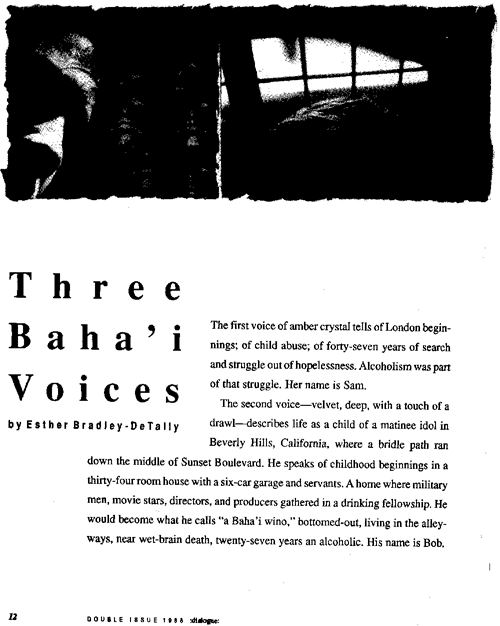 click for larger image |
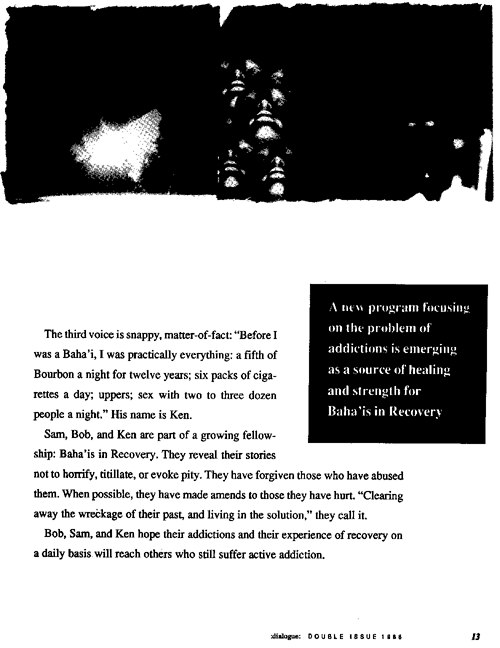 click for larger image |
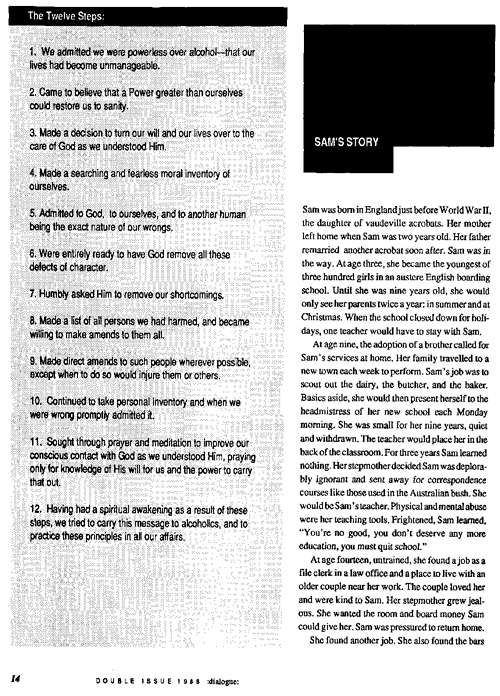 click for larger image |
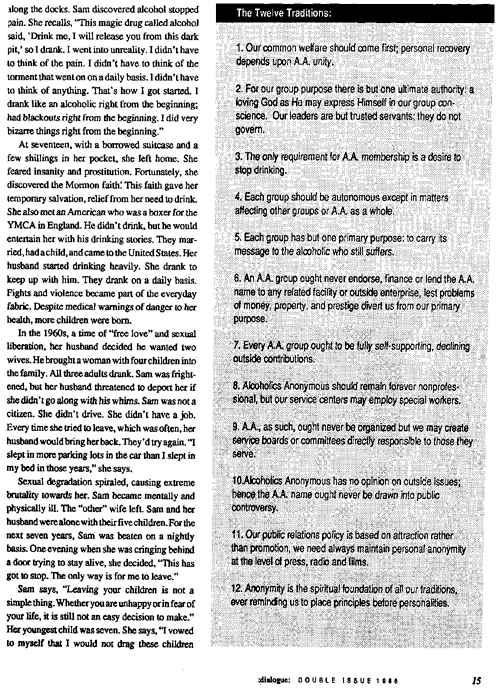 click for larger image |
 click for larger image |
 click for larger image |
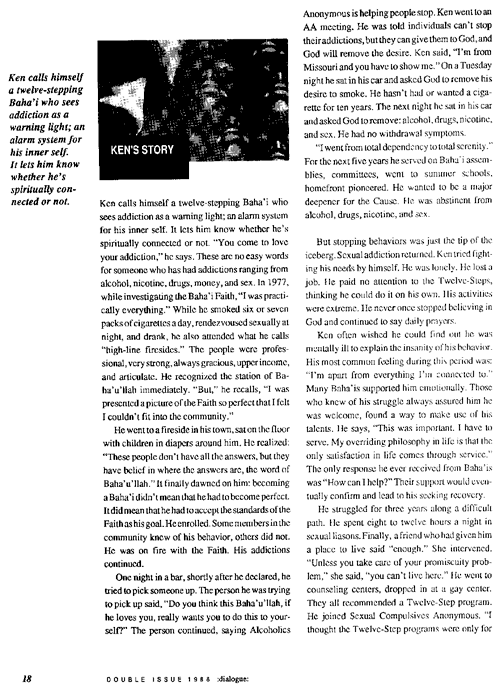 click for larger image |
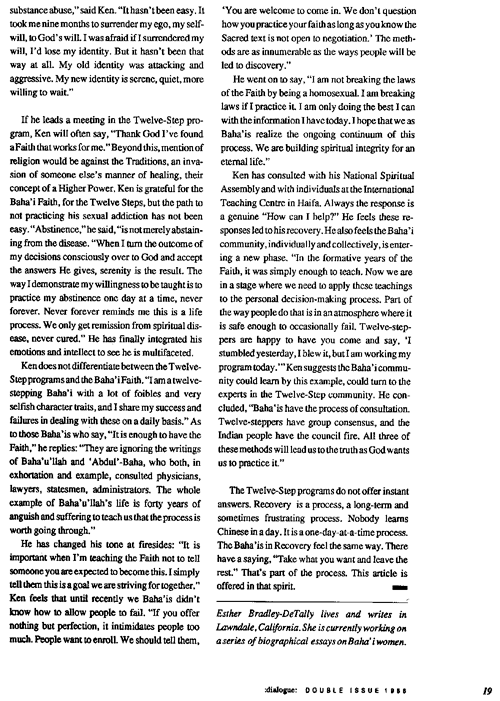 click for larger image |
This letter from Dann Irish, published in dialogue 2:1 p. 4, precedes the above article |
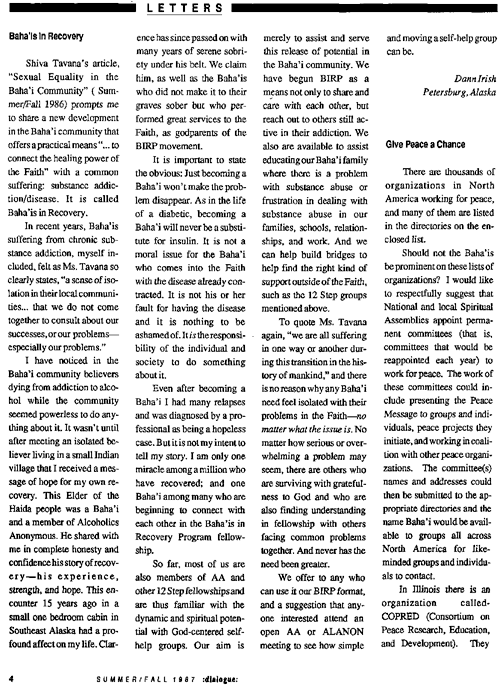 click for larger image |
|
|